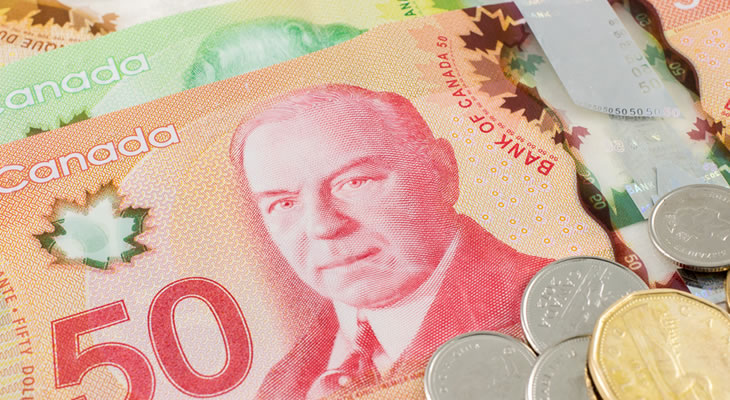- Pound Canadian Dollar Exchange Rate Rallies a Cent Overnight – Investor surprise at the BoE’s decision to hold rates sees Sterling skyrocket.
- Sterling Experiences Temporary Slide on Andy Haldane’s comments – BoE chief economist Haldane sets out need for definite stimulus by next month.
- Canadian Dollar Falls on Sliding Oil Prices – Risk appetite remains high but weak oil sees the ‘Loonie’ fall.
- Pound Canadian Dollar Pairing Forecast to Move with Market Sentiment.
The Pound Canadian Dollar exchange rate rallied yesterday on the news that the Bank of England (BoE) would not be cutting its already record low interest rate below 0.50% and would leave its quantitative easing targets as they are.
Previous jumps in oil prices have seen the Canadian Dollar fight back against the rallying Pound over the last week but the recent return to a downtrend for black gold has seen Sterling hold-fast against the commodity-correlated currency.
Comments today by BoE central banker Andy Haldane that the institution must enact stimulus in the next Monetary Policy Committee meeting has seen the Pound start to slide as the recent optimism from the held rates dissipates.
Currently, the Pound Canadian Dollar exchange rate sits at 1.7244 after seeing some fluctuation due to Haldane’s comments.
Sterling (GBP) Restarts Week of Substantial Rallies on BoE Holding Rates at 0.50%
The Pound has enjoyed a full week of sustained rallies thanks to Theresa May’s accession to Prime Minister and the Bank of England (BoE) holding fire on its expected rate cut this month.
The only day Sterling saw significant declines was Wednesday as the relief rally that started on Andrea Ledsom’s departure from the Tory party leadership race gave way to increasing fears the BoE would elect to slash rates on Thursday.
Previous immense political turmoil was somewhat cleaned up on Monday after Conservative party leadership hopeful Andrea Leadsom conceded the leadership contest to Theresa May.
The Pound rallied as May is generally seen as the stronger candidate due to her previous cabinet experience and pro-‘Remain’ ties. Many are inclined to believe she would garner a fair deal for the UK as it leaves the European Union due to these facts and she even managed to quell pro-‘Leave’ detractors as she announced ‘Brexit means Brexit’ as one of her first acts.
Markets had readied themselves for the BoE to cut rates to historically low levels in reaction to the economic circumstances surrounding the UK. This led to an 80% implied probability that the bank would cut, so when it was revealed that rates would be left on hold, the Pound saw remarkable increases across the board.
The Monetary Policy Committee has elected instead to wait for more concrete data to come out from the post-Brexit vote period before making a decision, with some analysts taking this to mean the bank may even hold next month.
However, today’s comments from Bank of England’s chief economist Andy Haldane have seen the Pound fall back into decline as he stated that the central bank will indeed have to enact loosening next month:
‘In my personal view… a material easing of monetary policy is likely to be needed, as one part of a collective policy response aimed at helping protect the economy and jobs from a downturn.
Given the scale of insurance required, a package of mutually complementary monetary policy easing measures is likely to be necessary.’
Canadian Dollar (CAD) Wounded by Sliding Oil Prices
Previously strong oil prices saw the Canadian Dollar put up a decent fight against the Pound midweek but as the price of crude began to slide again, the ‘Loonie’ lost ground against Sterling.
As the Bank of England’s decision to keep rates on hold made the news, the pairing shot up during the late morning on Thursday and held gains until the central bank’s Andy Haldane hinted at the definite probability of economic stimulus being enacted in August.
As another ten-year treasury slipped into negative yields, this time German Bunds, investors were turned away from most safe-haven assets apart from gold as the US Dollar saw a marked decline over the week.
As a result, traders were attracted to the more lucrative commodity currencies, such at the Canadian and Australian Dollars, which have both tracked favourably over the past four days. The ‘Loonie’ found further support as the Bank of Canada (BOC) also left rates on hold at 0.50% during its announcement on Wednesday afternoon.
Previously strong commodities and global equities kept risk appetite fairly potent but the Canadian Dollar has fallen out of favour somewhat on the aforementioned slip in oil prices while the Australian Dollar remains in demand.
Market Sentiment to Affect GBP/AUD Forecast due to lack of Impactful Ecostats
With no high-impact ecostats from the UK set for release until Tuesday, any movement for the Pound will likely come from either government murmurings during the final moments of the cabinet reshuffle or comments from central bankers and policymakers regarding the UK’s economic outlook.
However, next week’s inflation report could enact movement for the currency if the figures print worryingly high in response to rising import costs for retailers and traders within the UK. Shining a spotlight on the negative consequences of the Brexit is likely to see Pound depreciation.
No reports of note are being released from Canada until next Friday when both Canadian inflation figures and retail sales are published.
If the retail sales report shows a marked increase in spending it could lend credence to the fact that the Canadian economy is attempting to recover.
Core inflation sits at 2.1% and if the figure rises then the Bank of Canada (BOC) may be forced to tighten monetary policy in response.
Ultimately it will be market sentiment in the coming days that’s likely to cause any movement for the Pound Canadian Dollar exchange rate.


Comments are closed.